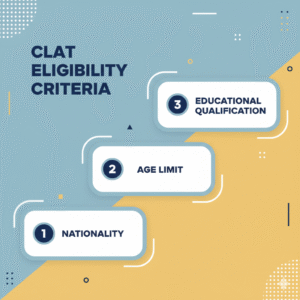The Common Law Admission Test, or CLAT, is a national entrance exam for students who want to join undergraduate or postgraduate law courses at leading National Law Universities (NLUs) in India. It is organised every year by the Consortium of NLUs.
For the 2026 session, the exam will take place on 7 December 2025 in offline mode (pen and paper) across more than 130 test centres in India. The registration process ended on 7 November 2025.
CLAT Eligibility 2027
During the counselling process, the CLAT Consortium verifies the eligibility of shortlisted candidates, and candidates are required to present supporting documentation to ensure their admission.

CLAT Eligibility Criteria for UG
The CLAT Consortium follows the eligibility criteria for law LLB / UG courses set forth by the Bar Council of India, which is India's governing authority for legal education and professional standards.
CLAT Qualifying Marks for LLB
- Currently in class 12 or have completed class 12 from a recognised board.
- General/OBC/PWD/NRI/PIO/OCI: A minimum of 45% aggregate marks.
- SC/ST: Minimum of 40% aggregate marks in class 12.
- Current class 12 students scheduled to take the March/April 2026 exams may apply, but proof of passing is required at enrollment.
CLAT Age Limit for LLB
There are no age restrictions for the CLAT 2027 UG exam.
CLAT Eligibility For NRI Students
If you are an NRI aspirant seeking admission under the NRI quota, you must meet particular CLAT eligibility criteria and complete the admission steps.
- Admission is based on merit scores, and the university determines the CLAT Seat Allotment under the NRI Quota.
- Contact the university for admission information, eligibility, required paperwork, and other questions.
- If foreign national seats are unavailable, they will be converted into NRI/NRI-sponsored seats, with admission determined by CLAT ranking.
- The CLAT Office will release a list of eligible candidates for admission in this category.
Documents Required for CLAT NRI-Sponsored Candidates
The sponsor must furnish these documents:
- Please provide a copy of the sponsor's valid Indian passport, visas obtained within the last 12 months, and
- a certificate from the local embassy confirming NRI/OCI status or a PIO Card.
- An affidavit from the sponsor expressing interest in the student's education and willingness to pay for it for the next five years.
CLAT Eligibility for PG
This section contains extensive CLAT 2027 eligibility criteria for PG / LLM courses, which candidates can review before filling out the application form to avoid disqualification at a later stage of the exam.
CLAT Educational Qualification for LLM
- If you are in the final year of your qualifying examination, you may apply for CLAT PG 2025. However, you must present your final year mark sheets when applying for admission.
- To be eligible for the CLAT PG 2027, you must have a minimum of 50% in LLB or a comparable degree from a recognized university.
- The minimum percentage necessary for SC/ST candidates is 45%. Age relaxation of 5% is provided.
CLAT Age Limit for LLM
There is no upper age limit for the CLAT PG exam; therefore, people of any age can enroll for LLM studies.
However, the minimum age to apply for the exam is over 20 years old, underscoring the importance of the CLAT qualifying age even for postgraduate legal degrees.
CLAT Nationality
- According to the previous year's official notification, Indian Nationals, Non-Resident Indians (NRIs), Overseas Citizens of India (OCIs), Persons of Indian Origin (PIOs), and Foreign Nationals can apply for the CLAT PG Exam 2027.
- However, NRIs and foreign nationals must apply for the exam through the NRI quota provided by CLAT participating colleges.
